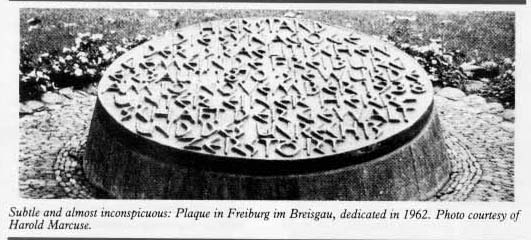
UC Santa Barbara > History Department > Prof. Marcuse > Publications Page > 1986 manuscript for Dimensions
by Harold Marcuse, 12 December 1986 (back
to homepage)
Manuscript written for the vol. 3, no. 2 (1987) issue of Dimensions: A Journal of Holocaust Studies.
The published version (with illustrations) was shortened by the guest editor from 10 pages to 2.
page 1, page 2
October 2014:French version by Natalie Harmann: "Commémoration de l’Holocauste: Une stratégie pour l’Allemagne de l’Ouest." (close to Google translate)
July 2015: Polish version by Abdul Sattar: "Obchody Holokaustu: Strategia Dla Niemiec Zachodnich," who assures me it was checked by four native speakers. Sattar's couponmachine.in website supports various social programs, including translation services.
There are four basic types of Holocaust memorials in West Germany:
The first type of memorial serves a dual purpose. On the one hand, it identifies the lost school, synagogue etc. as a valuable cultural object, contributing to the worth and historical identity of the community. On the other hand it documents the willful destruction of that object, if not explicitly, then at least by the fact that there is no longer anything there. This half-positive, half-negative dichotomy is the distinguishing feature of these monuments; the possibility of interpreting the event positively accounts for their prevalence.
In contrast, memorials marking places of persecution are exclusively negative. Not only is the positive feature of having been a culturally valuable object missing, but it is also more difficult to conceal the fact that human beings, not property, were the prime targets of the violence. Thus these memorials are inconspicuous and relatively rare.
Memorials in Jewish cemeteries, Jewish community centers, and synagogues, however, are not affected by the negative character of the events. They serve to strengthen a group identity among Jews, which, as Alvin Rosenfeld has shown in the preceding issue of this journal, is primarily defined by negative experiences during centuries of persecution and discrimination.
The final type of "blanket" memorial serves a similar function for the community at large as do those in Jewish cultural centers for Jews: the foundation of a communal identity. Because of their integrative purpose all-encompassing victims' memorials tend to focus on positive aspects and values; where this is impossible, the memorials are usually vague and inconspicuous, as in cities like Frankfurt/Main, Hamburg and Munich.[1]
Synagogue memorials are by far the most common form of Holocaust commemoration in the Federal Republic. They usually do little more than state the fact that a synagogue existed at that location and name the date when it was desecrated or destroyed. One example is in Zuelpich, a small town in the vicinity of Cologne. Its inscription reads:
Here stood the Jewish synagogue.
Destroyed on 8 November 1938.
This is typical of plaques and monuments erected in the 1950's. During that decade there were extremely few Jews in Germany (ca. 30,000), and the population at large was busy rebuilding the war-torn economy. In the shadow of the Cold War, while West Germany was being re-armed and integrated into the Western alliance, almost no one was concerned with the moral reconstruction of the country. National-Socialist genocide was perhaps too significant historically to be completely ignored, but focusing on the issue might have alienated many of the rehabilitated former party members now running the state.
Around 1960 a wave of anti-semitism swept across the country. The Eichmann-trial
in Jerusalem (1961) and the preparations for the Auschwitz trials in Frankfurt/M.
(1963-65) brought the atrocities of the Nazis back into public consciousness.
A new type of message became common on synagogue memorials: one that added moral
condemnation to the innocuous documentation of the earlier markers. Nonetheless,
the fear of arousing resentment in the general population was still so great
that the monuments were usually extremely difficult to recognize. Typical is
a manhole-sized plaque in Freiburg/Br., which was established in 1962 and reads:

Here stood the synagogue of the Israelite Community in Freiburg, built 1870. It was destroyed on 10 November 1938 under a regime of violence and injustice.
This monument, however, was so successfully concealed from view by a cluster of bushes that even longtime employees of the nearby university institutes didn't know of its existence. Not until 1985 were its surroundings changed. It was brought out into the light and prominently marked by a small path.
Yet another strategy was commonly used on many memorials erected in the later 1950's and the 1960's. The reference to the 1938 pogrom was kept to a bare minimum, and the synagogue was presented as a lost object of high cultural value. A marker erected for the Offenbachplatz-Synagogue in Cologne points out not the circumstances of the destruction, but rather links the synagogue to the city's world-famous cathedral:
A synagogue built from 1857-1867 according to a design by the master-builder of the cathedral, E. Zwirner, stood on this spot. A gift from A. Oppenheim.
Destroyed on 9 November 1938.
By the mere fact of its existence the memorial appeased those morally outraged by the antisemitic violence, but the interest it creates in the architecture of the synagogue ultimately achieves a positive effect: it relieves those implicated in the pogrom, distorting the past to provide a basis for a renewed communal identity.
In some cases, especially where religious communities were involved, the opposite tack was taken. Indignant accusation with an undertone of self-righteousness was the result, as in the village of Lemgo in North-Rhine/Westfalia:
Here stood since 1883 the House of God of the Jewish Community. It was destroyed by Germans on 8 November 1938. The Christian communities of Lemgo and Brake warn:
This guilt is not to be forgotten.
Especially noteworthy in these last 2 examples is the attempt to strike a resonant chord in the community. While the residents of Cologne are expected to accept the Jews as important fellow citizens of the city, the inhabitants of Lemgo are called upon as Christians to see the Jews as fellow believers in God. It is important to note, however, that there is no mention made of the violence done to the Jews themselves. The desecration of property is considered more important than the violation of fundamental human rights.
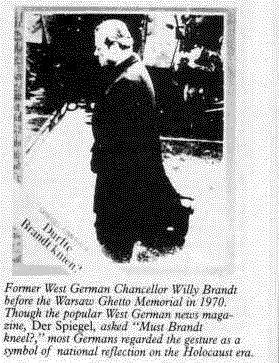 It
was not until the 1970s, and in many cases the 1980s, that a new perception
of the Holocaust started to take root in West German society. As the generation
of former Nazis and sympathizers slowly retired out of positions of power and
became numerically less prevalent, public consciousness of the Holocaust was
raised by further trials of National-Socialist perpetrators, by the student
movement and the general liberalization of society. Chancellor Willy Brandt
kneeling in front of the memorial in the Warsaw ghetto in 1970 was a powerful,
if somewhat premature symbol of the change. Out of this climate of honest reflection
about the genocidal schemes implemented by the preceding regime were born such
inscriptions as the one in the village of Alsfeld in Hesse:
It
was not until the 1970s, and in many cases the 1980s, that a new perception
of the Holocaust started to take root in West German society. As the generation
of former Nazis and sympathizers slowly retired out of positions of power and
became numerically less prevalent, public consciousness of the Holocaust was
raised by further trials of National-Socialist perpetrators, by the student
movement and the general liberalization of society. Chancellor Willy Brandt
kneeling in front of the memorial in the Warsaw ghetto in 1970 was a powerful,
if somewhat premature symbol of the change. Out of this climate of honest reflection
about the genocidal schemes implemented by the preceding regime were born such
inscriptions as the one in the village of Alsfeld in Hesse:
Here stood the synagogue, dedicated 1905, destroyed by National Socialist terror on 9 November 1938. The sufferings of the Jewish people call for the defense of human rights, for resistance against violence and against the unjust persecution of those with different beliefs.
For the first time the inscription goes beyond an appeal to outrage at the destruction of property and mentions the people who were the real targets of the "violence and injustice". Of course, the euphemism "National-Socialist terror" for the perpetrators is still necessary in order not to alienate that segment of the population. This perceptual change has not only manifested itself in the inscriptions. In many towns and cities small plaques are being replaced by sculptures with more informative inscriptions, and former synagogues are being restored - often as museums for documentation and research of the Holocaust, as in the industrial metropolis Essen or the village Michelstadt near Frankfurt/M.
With all of these attempts at more and better documentation, it is striking that only in the rarest of cases any attempt is made to make the memorials historically concrete. The significance of this will become clear if we look theoretically at the way the commemorative process works. It can be conveniently described as a process of identification. I distinguish four stages:
In practice, these stages appear as a sequence of events:
The most important step in the identification process is the transition from the third to the fourth stage: making a statement on the one hand concrete and personal enough to "hook" the viewer into relating to the subjective historical object, while on the other hand being general enough that viewers will transcend the specific past and recognize and relate its "lesson" to present society. An effective monument should be formed and phrased in such a way that it makes the strongest possible impression upon as many people as possible; it should also embody values significant to all of society.
Within this theoretical framework it is relatively easy to understand the development of the inscriptions of West German synagogue memorials over time. After an initial ineffectual minimalist conception, the "injustice" of the event was singled out as being important, but no attempt was made to reach the public. When memorials did attempt to move viewers to relate the message to themselves, they usually distorted the significance of the Holocaust. They appealed to viewers as Christians or as citizens of a city, leaving out exactly the significant aspects for fear of alienating large segments of the population. Especially references to the violence done to people were avoided. It was not until much later that viewers were appealed to on broad humanitarian grounds; only then could a positive appeal be formulated that did not deny the past reality of the Holocaust.
A look at one of the monuments commemorating acts of persecution illustrates
how difficult it is to strike a balance between being historically concrete
while still embodying positive values fundamental to society. Hitler's plans
for a "Jew-free" Germany called for the creation of ghettos and deportation
camps in countless cities and towns across the country. The overwhelming majority
of these places remain unmarked; the few existing memorials were established
in rare cases since the late 1960's, but primarily since the late 1970's. 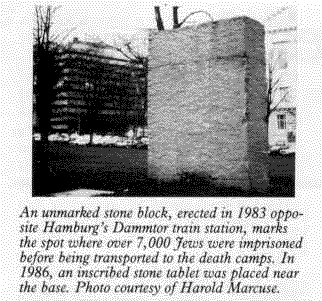 One
of them, erected in 1983, can be found opposite Hamburg's Dammtor train station.
A dark bronze plaque concealed in the shade of some bushes about 10 meters from
a large unshaped block of stone reads:
One
of them, erected in 1983, can be found opposite Hamburg's Dammtor train station.
A dark bronze plaque concealed in the shade of some bushes about 10 meters from
a large unshaped block of stone reads:
In memory of the Jewish fellow-citizens of Hamburg who in the days of the National Socialist terror-regime were sent to death by the thousands.
Don't forget it. Be watchful.
This memorial is representative not only in that it is, although located at a prominent point, almost impossible to recognize as a monument, but also in that the murdered people are reduced to an immaterial order of magnitude (close to 8000 Jews were deported from Hamburg). Additionally, the historical circumstances are made as vague and innocuous as possible. The ritual "terror-regime" is once again the perpetrator - in Hamburg's case it is implied to have been in power only for "days" (in German, "days" does not mean "time," as it can in English). Neither the location of the camp, nor its dates of existence, nor the exact number or names of those destined for the gas chambers are disclosed. Such memorials serve only as alibis for real confrontation with the Holocaust.
This example epitomizes the weakness in the commemorative strategy employed in almost all West German Holocaust memorials. First of all, for fear of alienating viewers, the historical circumstances of the Holocaust are made so vague that no one might think of the people like themselves whose lives were violated. The monument is concealed in such a way that it cannot reach a broad audience. Secondly, euphemistic formulations conceal the imperative nature of incorporating the past transgressions into one's perception of present society. The real purpose of establishing public Holocaust memorials - securing the moral basis of society - is thwarted. Finally, insipid appeals like "This guilt is not to be forgotten!" or: "Be watchful!" only thinly hide the sell-out.
This analysis implies that a commemorative strategy should be developed which personalizes the Holocaust, bringing it back to the level of real people in daily life. This would entail visibly marking the locations where the Holocaust transpired - at the collection points and train stations as well as at the torture cells and gas chambers. Memorials would also have to contain concrete information, such as the names of those murdered. This device was employed very effectively in the recently dedicated Vietnam Veterans' Memorial in Washington, D.C., where 58,007 names (some more have been added in the meantime) are engraved in black granite with symbols depicting whether the soldiers are confirmed dead or are still unaccounted for. The possibility of incorporating new information underscores the actuality of the event; it is not a reason for sparing exactness.
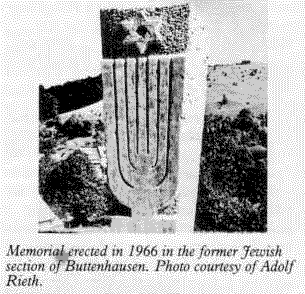 This
does not suggest that monuments be turned into documentary museums: they should
only contain enough detailed information that viewers can relate to them on
a personal level. It is necessary to have a kind of commemorative "division
of labor," with educational programs to provide an interpretative context
for the Holocaust, and memorials integrated into daily life which would anchor
it in public consciousness. A survey of visitors to the memorial site at Dachau
illustrates this point. A high percentage of them only walked through the grounds
without entering the museum. This behavior is typical for a large proportion
of the general population. They might take note of a memorial, but they are
loathe to invest the additional effort of going through a museum. Thus a national
"House of Documents," like the one proposed for Bonn should accompany,
not replace, a national memorial.[2]
This
does not suggest that monuments be turned into documentary museums: they should
only contain enough detailed information that viewers can relate to them on
a personal level. It is necessary to have a kind of commemorative "division
of labor," with educational programs to provide an interpretative context
for the Holocaust, and memorials integrated into daily life which would anchor
it in public consciousness. A survey of visitors to the memorial site at Dachau
illustrates this point. A high percentage of them only walked through the grounds
without entering the museum. This behavior is typical for a large proportion
of the general population. They might take note of a memorial, but they are
loathe to invest the additional effort of going through a museum. Thus a national
"House of Documents," like the one proposed for Bonn should accompany,
not replace, a national memorial.[2]
The monument for the deportation camp in Stuttgart-Weissenfeld goes a step in the right direction, but not far enough. The inscription on a slender stone column nestled in the trees at the edge of a large park reads:
In memory of more than 2000 Jewish fellow-citizens who, during the time of catastrophe in the years 1941 and 1942, were sent from here on their trip of suffering into the concentration camps and into death.
Erected by the City of Stuttgart.
Although it is relatively specific, it is still impersonal, hard to find, and not supported by the availability of detailed historical information.
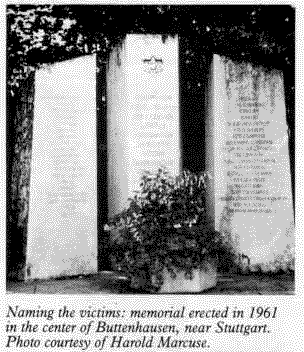 To
my knowledge the only public Holocaust memorial in West Germany that names the
victims is one erected by surviving members of the Jewish community in the center
of the small village of Buttenhausen near Stuttgart in 1961. Two columns, each
inscribed with nineteen names, flank the central memorial which stands prominently
at the town's main intersection. A large synagogue memorial in the former Jewish
section and the restored Jewish cemetery complete the memorial ensemble, while
a small, privately run exhibition is accessible to interested viewers.[3]
In all of West Germany, it is perhaps Buttenhausen that comes closest to having
an optimal strategy of Holocaust commemoration.
To
my knowledge the only public Holocaust memorial in West Germany that names the
victims is one erected by surviving members of the Jewish community in the center
of the small village of Buttenhausen near Stuttgart in 1961. Two columns, each
inscribed with nineteen names, flank the central memorial which stands prominently
at the town's main intersection. A large synagogue memorial in the former Jewish
section and the restored Jewish cemetery complete the memorial ensemble, while
a small, privately run exhibition is accessible to interested viewers.[3]
In all of West Germany, it is perhaps Buttenhausen that comes closest to having
an optimal strategy of Holocaust commemoration.
To sum up, it is necessary not only to make memorials more visible and more
personal, but also to replace vapidly moralizing appeals with concrete historical
education. The Holocaust is such a complex phenomenon that its consequences
cannot be reduced to a collection of trite phrases. It is beyond the scope of
a memorial to actually draw conclusions, lessons from history - this only the
viewer can do. Commemorative art is always embedded in a social context which
it helps to shape while at the same time being shaped by it. Only through a
comprehensive educational program including an objective treatment of the Holocaust
in all of its aspects can we hope that individuals will realize its significance;
only then can we be assured that Holocaust memorials of all designs will fulfill
their essential purpose.
------------------------------------------
[1]Due to constraints of space no examples of this type
of monument can be discussed in this article. Many such "blanket" memorials
in West Germany are analyzed in depth in: H. Marcuse, F. Schimmelfennig, J.
Spielmann: Nationalsozialismus und Zweiter Weltkrieg in Denkmalen, 1945-1985
(Hamburg: Museum fuer Hamburgische Geschichte, 1985). (back to
text)
[2] There is currently a hotly contested debate in West Germany about erecting a national memorial to all German "victims" of Nazism--including the dead of Hitler's armies. The opposition parties contend correctly that one cannot make a distinction between Germans and non-Germans, but that one must distinguish between innocent victims and "victims" who were perpetrators. [ref. to what has become known as the "Historians' Debate."]. (back to text)
[3] The synagogue memorial and the restoration of the cemetery are documented in: Adolf Rieth: To the Victims of Tyranny/Den Opfern der Gewalt (London/Tuebingen, 1968). (back to text)
back to top, back to H.
Marcuse homepage
[first posted ca. 1995?; updated 10/20/14 with link to French translation, 7/20/15 link to Polish translation]